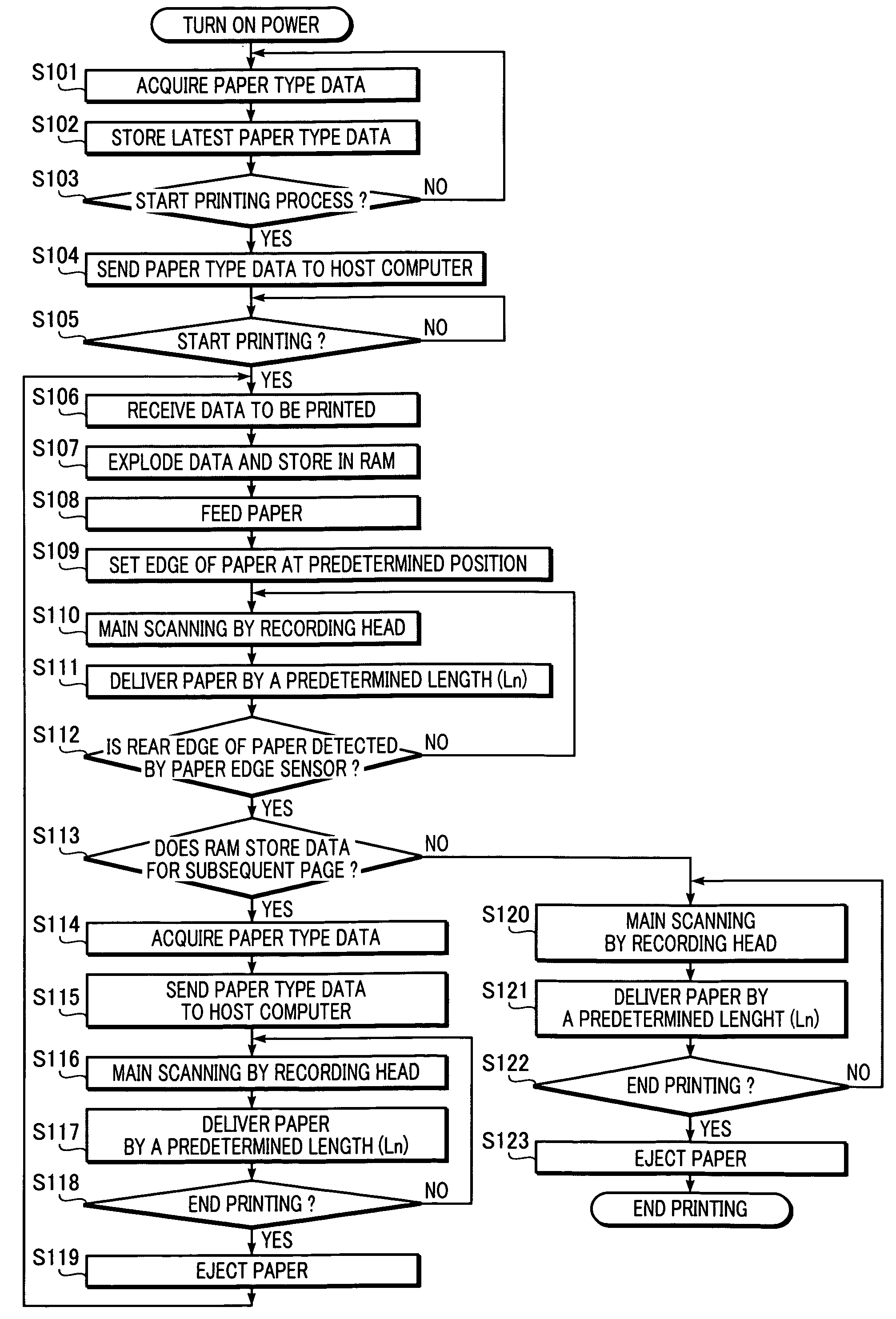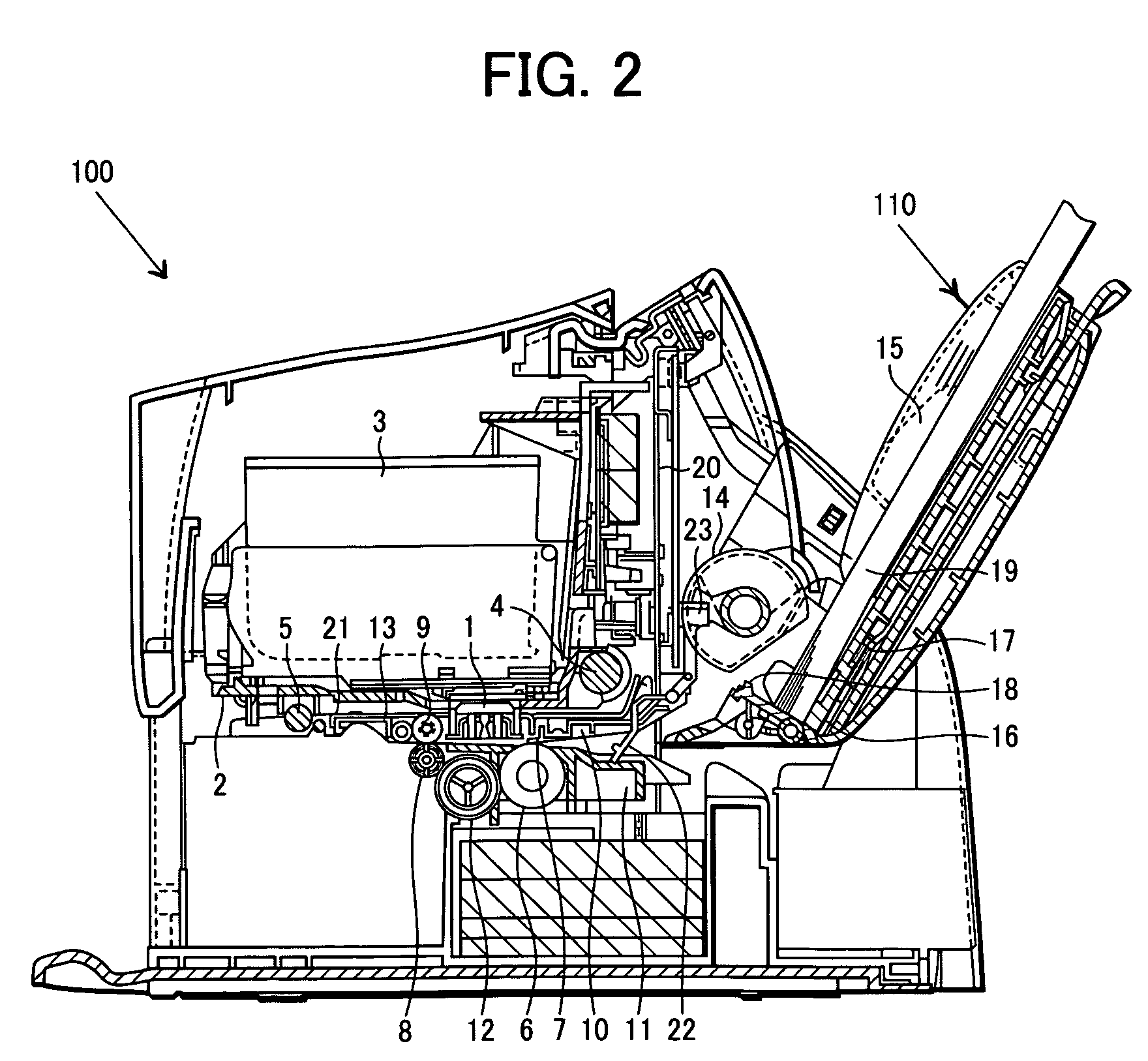Recording apparatus and method for discriminating type of recording medium
a recording apparatus and recording medium technology, applied in the field of recording apparatuses, can solve the problems of difficult to identify the type of recording medium in the loading unit, the process of inputting data on the recording medium is complicated, and the user is difficult to recognize input, and achieves a high-reliable recording suitable for the type of recording medium
- Summary
- Abstract
- Description
- Claims
- Application Information
AI Technical Summary
Benefits of technology
Problems solved by technology
Method used
Image
Examples
first embodiment
[0030]A first embodiment of the present invention will be described with reference to FIGS. 1 to 5.
[0031]FIG. 2 is a longitudinal cross-sectional view of a recording apparatus 100 in accordance with a first embodiment of the present invention. FIG. 3 is a longitudinal cross-sectional view of a feeding unit 110 of the recording apparatus 100 shown in FIG. 1.
[0032]In FIG. 2, an inkjet recording head 1 is for recording data on a recording medium. The inkjet recording head 1 is mounted on a carriage 2 that moves in a main scanning direction. An ink tank 3 is for supplying ink to the inkjet recording head 1 mounted on the carriage 2. Carriage axes 4 and 5 guide the carriage 2 during the main scanning. A first delivery roller 6 for delivering the recording medium is disposed upstream of a delivering direction to a recording region where data is recorded on the recording medium by the inkjet recording head 1. A first driven roller 7 is disposed opposite the first delivery roller 6. A first...
second embodiment
[0057]In the first embodiment, the type of each recording medium 19 used for recording a document is identified when the document includes a plurality of pages and, then, the recording medium-type data is used for achieving recording suitable for the recording medium 19. The second embodiment, on the other hand, identifies the type of every medium of the recording medium when each page is recorded. Then, if the type of recording medium used for a previous recording and the type of recording medium used for a subsequent recording differ, the user is notified that the type of recording medium differs so that the user can decide whether or not to continue the recording. The descriptions of the structures of the recording apparatus and the control system according to the second embodiment are omitted since they are the same as the structures of the first embodiment.
[0058]FIG. 6 is a flow chart describing a control process of the recording apparatus according to the second embodiment.
[00...
third embodiment
[0072]In the above-mentioned first and second embodiments, whether or not data for a subsequent page of the document is stored in the RAM is confirmed (S112 and S113 of FIG. 1 or S212 and S213 of FIG. 6) after the trailing edge of the recording medium 19 used for recording the previous page of the document is detected. In this embodiment, whether or not data for a subsequent page of the document is stored in the RAM is confirmed before the trailing edge of the recording medium used for recording the previous page of the document is detected. If it is confirmed that data for a subsequent page of the document is stored, the type of the next recording medium is identified.
[0073]The type of recording medium to be used for recording a subsequent page of the document can be identified before the trailing edge of the previous recording medium used for recording the previous page of the document is detected by a recording medium-type sensor 42 when a predetermined length of the previous pag...
PUM
 Login to View More
Login to View More Abstract
Description
Claims
Application Information
 Login to View More
Login to View More - R&D
- Intellectual Property
- Life Sciences
- Materials
- Tech Scout
- Unparalleled Data Quality
- Higher Quality Content
- 60% Fewer Hallucinations
Browse by: Latest US Patents, China's latest patents, Technical Efficacy Thesaurus, Application Domain, Technology Topic, Popular Technical Reports.
© 2025 PatSnap. All rights reserved.Legal|Privacy policy|Modern Slavery Act Transparency Statement|Sitemap|About US| Contact US: help@patsnap.com



